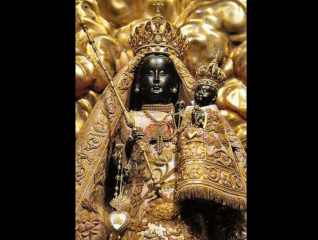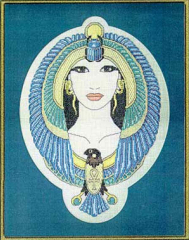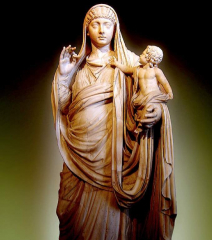To the South of France
So what form of Christianity did the Goths find in their new state and how had it been propagated independent of the Roman Church?
The legends, and they are only legends, are very strong. Mary Magdalene travelled from Judea with the help of Pontius Pilate, the Roman Governor. She came to either Languedoc or Provence( there is some disagreement on this point because there were two “Lugdiniums “). She travelled via Egypt “in a boat without oars” i.e. a sailing ship and recommenced the ministry, which had stated in Judea.
Joseph of Aramathea
Several disciples accompanied her, chief amongst whom was Joseph of Aramathea. Together they quickly established a ministry through the Western Romano-Celtic lands. This included the British Isles, where Joseph had extensive contacts due to his position as a Roman Decurion, a trader in precious metals.
Joseph was Jesus’ great uncle and had taken Jesus to Britain on one of his trading trips when he was very young. Hence the “Walk upon England’s mountains green” The Celtic Rite developed independent of the Jewish Rite, which spread through the Eastern Empire. The first Bishop of Rome was not Peter but Linus, a Royal Celt practicing and promoting Magdalene’s teaching.
The Gospel of Mary
 In her darkest moments Ximene seeks inspiration from Mary Magdelane, whom she believes was more than an apostle. She was an equal partner and shared Jesus bloodlines. She helped Jesus formulate his teaching.Magdalene’s role as an apostle is perhaps supported by the discovery of the Nag Hammadi Library and specifically what is known as the Gospel of Mary. It is interesting this Gospel is included with a great many Gnostic Texts.
In her darkest moments Ximene seeks inspiration from Mary Magdelane, whom she believes was more than an apostle. She was an equal partner and shared Jesus bloodlines. She helped Jesus formulate his teaching.Magdalene’s role as an apostle is perhaps supported by the discovery of the Nag Hammadi Library and specifically what is known as the Gospel of Mary. It is interesting this Gospel is included with a great many Gnostic Texts.
Saint or Sinner?
The legend of Mary Magdelene’s Presence in the South of France was supported by the Church of Rome. The legend was twisted however to make her a repentant sinner rather than an Apostle. The legend is still celebrated today. The most famous celebration is that at
Saintes Maries de la Mer where statues of not one but three Marys are carried through the streets, representations of Mary Magdalene, Mary Salome (wife of Clopas) and Mary Jacobe (the mother of James the less) all mentioned in the gospels as being present after Jesus’ death when all the other apostles had “run Away”. The festival also celebrates the involvement of Sarah the Egyptian, who is considered to be a servant to the Marys , but perhaps not.
Tolerance and Consideration
What Magdalene’s teaching might have been we really do not know, but it must have continued to promote Jesus as the source and authority for the teaching. The teaching itself must have been similar to the blend of Arian faith, Manichaeism and Gnosticism espoused by the Goths. What we do know is that the faith accepted both Arian and Trinitarian believers with generosity and consideration at least five hundred years before the Trinitarian church of Rome felt powerful enough to condemn it at the Synod of Whitby and a full thousand years before the Albigensian crusade made it impossible to practice the faith openly.
The Black Madonnas
 The veneration of the Madonna is of Mary Magdalene not of Mary, Jesus' mother. She has given dark skin because she was dark skinned. Jesus’ choice of her as a partner symbolises that the final part of Jesus message was that racial differences are as unimportant as religion or nationality. His message is for all peoples and races. For a magical moment in time Magdelene won the support or at least the tolerance of the Roman Emperors. She was the fount of grace, love and mercy, she is the example Ximene vows to follow. There is however another possibility.
The veneration of the Madonna is of Mary Magdalene not of Mary, Jesus' mother. She has given dark skin because she was dark skinned. Jesus’ choice of her as a partner symbolises that the final part of Jesus message was that racial differences are as unimportant as religion or nationality. His message is for all peoples and races. For a magical moment in time Magdelene won the support or at least the tolerance of the Roman Emperors. She was the fount of grace, love and mercy, she is the example Ximene vows to follow. There is however another possibility.
When the Goths arrived in what is now Southern France they would have encountered another phenomenon, the reverence for the Black Madonna. Although Black Madonna’s can be found in most european countries the greatest concentration is in the very area where Mary Magdalene is reputed to have carried out he ministry.
One explanation is that she had dark skin and therefore it is only natural that statutes of her would be depicted with dark skin,but once again there is another possibility.
In parallel with the growth of Roman Christianity another faith was growing strongly in the Roman Empire. The godhead in this faith was not a man, but a woman – Isis the God of Egypt. At the time of Jesus’ teaching, Isis had been worshipped in Egypt for well over 4000 years. Isis was well known outside of Egypt. Her temples were found all over the known world.
Isis
 In the early years of christianity the Ankh, an Egyptian symbol was used as a Christian symbol, particularly in the celtic nations.
In the early years of christianity the Ankh, an Egyptian symbol was used as a Christian symbol, particularly in the celtic nations.
There then followed three hundred years when the Christianity and the worship of Isis continued. Co-existence is perhaps too strong a word to use! Constantine attempted to control conflict, by declaring freedom of religious belief.
He was horrified at how quickly beliefs fragmented and became a source of civic disruption. Disturbed by increasing conflict and convinced that the Capital of his Empire should move east to Byzantium, Constantine decided in 310 that the Eastern Version of Christianity should be the Religion of the Empire.
Despite this decision Isis was still venerated in public ceremonies until the 6th century It was as late as 490AD when the worship of Isis was finally stamped out by an ever more powerful Roman Church. A special point was made of establishing churches dedicated to the Virgin Mary in or on the site of temples to Isis.
Isis was also often depicted as having dark skin.
There is no record of which ministry promoted the cult of Isis during the intervening period, but obviously it was promoted and the promotion lasted for a significant period.
Mother and Child
 Setting aside images of the Crucifixion, one of the most enduring images of the Christian era has been the image of mother and child.
Setting aside images of the Crucifixion, one of the most enduring images of the Christian era has been the image of mother and child.
The imagery is strikingly similar to the images of Isis is nursing Horus, the first Pharaoh. Despite the similarity it must be emphasized that Isis was not only Horus’ mother but also the godhead of the Egyptian religion, superior all the other gods.
Terms of reverence
 Both Isis mother of Horus and Mary Mother of Jesus had other titles of adoration.
Both Isis mother of Horus and Mary Mother of Jesus had other titles of adoration.
There is a significant overlap. The use of Star of the Sea for both is very surprising, as Jesus mother has no discernable contact with the sea
Messalina and Britannicus, son of Claudius
There is another almost identical image to be found in the Louvre. This statue was apparently previously the property of Henry IV and was probably brought by him from Languedoc when he assumed the Throne of France. This is not considered to be either Iris nor Mary but the Empress Messalina holding her son Britannicus.
 Messalina’s husband and Britannicus’ father was the Emperor Claudius. She lived at a time when there was a great competition between the religion of Isis and Christianity for adherents within the Roman Empire.
Messalina’s husband and Britannicus’ father was the Emperor Claudius. She lived at a time when there was a great competition between the religion of Isis and Christianity for adherents within the Roman Empire.
We can assume that she played an important part in the politics of her time as she was dismissed by later Christian writers as a prostitute. It requires great inventiveness to label an empress as a prostitute. She apparently volunteered to work in a brothel in secret as a hobby!
